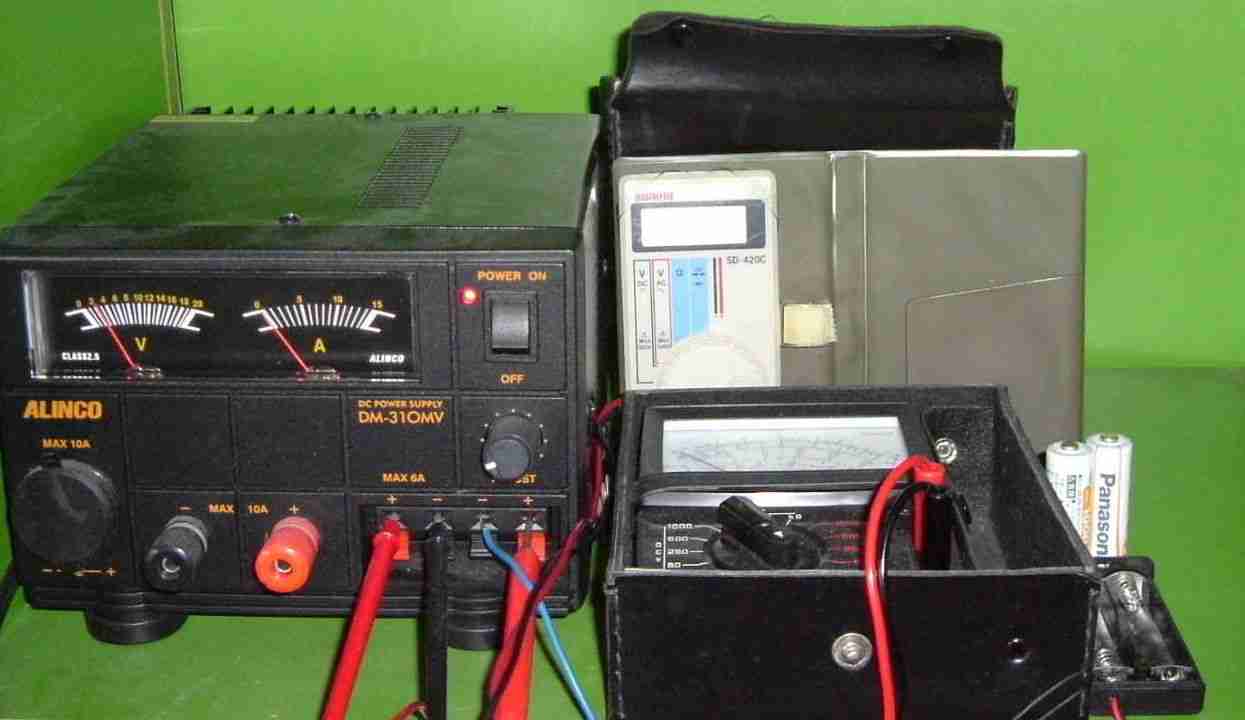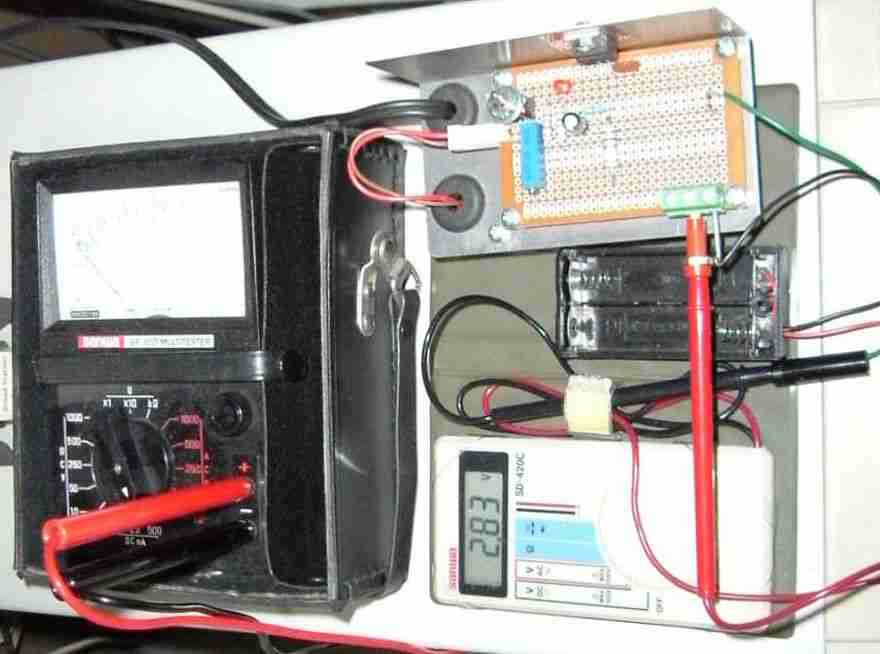Charging Ni-MH, NiCd batteries for Xbox360 controller
TweetMy son plays TV games for Xbox360 and the cable of the controller has broken. He told that his friends used Ni-H batterries for the controller. The controller has wireless function. His freinds did not replace the cable, as it is expensive. My son bought two Ni-H batteries. I told him not to buy a charger because I can charge them by my power supply. I recommend him to buy spares.
Charging tests for Eneloop and Evolta
I charged them measured by panel meter of my big power supply at first. I happned to test Eneloop and Evolta one another. I attached two testers for measuring current and volt. One is an old analog tester which was given by my father a long time ago. The tables shows the records of charging a pair of Ni-MH batteries for Eneloop and Evolta each.| Time | Volt | Current | Note |
| 14:21 | 2.68 | 160mA | Jun18 |
| 20:29 | 2.68 | 10mA | |
| - | 2.83 | 150mA | |
| 23:44 | 2.83 | 80mA | |
| - | 2.95 | 200mA | |
| 01:39 | 2.95 | 140mA | Jun19 |
| 10:04 | 2.95 | 50mA | |
| 15:12 | 2.95 | 55mA | Jun20 |
| 23:59 | 2.37 | Jun27 | |
| - | 2.61 | 150mA | |
| 21:27 | 2.7 | 150mA | Jul02 |
| 07:51 | 2.7 | 10mA | Jul03 |
| - | 2.92 | 200mA | |
| 10:19 | 2.92 | 135mA | |
| 10:24 | 2.92 | 125mA | |
| 11:28 | 2.92 | 30mA | |
| 16:30 | 3.03 | 140mA | |
| 16:30 | 3.03 | 110mA | Warm |
| 17:57 | 2.91 | 300mA | Jul13 |
| 20:41 | 2.98 | 90mA | Jul14 |
| 13:18 | 2.42 | - | Jul24 |
| 13:19 | 3.00 | 330mA | |
| 13:55 | 3.00 | 250mA | |
| 14:46 | 3.00 | 230mA | |
| 16:41 | 3.00 | 180mA | |
| 18:40 | 3.00 | 80mA | |
| 07:28 | 3.00 | 70mA | Jul25 |
| 18:58 | 3.00 | 70mA | warm |
| Time | Volt | Current | Note |
| 22:42 | 2.44 | - | Jun23 |
| - | 2.62 | 120mA | |
| 13:11 | 2.44 | zero | |
| - | 2.81 | 210mA | |
| 02:20 | 2.61 | - | Jul02 |
| - | 2.61 | 150mA | |
| 07:20 | 2.76 | 140mA | |
| 13:54 | 2.95 | 200mA | |
| 21:25 | 2.95 | ? | |
| 00:51 | 2.37 | - | Jul08 |
| 00:53 | 2.80 | 160mA | Jul08 |
| 16:04 | 2.99 | 185mA | Jul09 |
| 19:09 | 2.99 | 80mA | Warm |
| 19:09 | 2.91 | 20mA | |
| 00:08 | 2.92 | 40mA | Jul11 |
| 01:46 | 2.91 | 290mA | Jul17 |
| 14:05 | 3.03 | 130mA | Jul18 |

I found that both of Eneloop and Evolta have to charge less than 3.0V for a day. Batteries were warm, when I charged them over 3.0V for a long time. The data of Volt includes drop of current meter. The probe voltage is 40mV, when the current is 80mA. So the internal resistance is 0.5 Ohm. Drop voltage is 0.15V in case of 300mA, and is 5% of 3.0V. If I want to charge the Ni-H battery, It needs more than 60mA at least. Measuring devices are,
- Current: Sanwa SP-10D
- Volt: Sanwa SD-420C
- Power supply: Alinco DM-310MV
Check charging voltage again
I usually have charged two Evolta batteries that stays at little charging current for a day or two days. I found them very warm. They broke down, because I applied too high voltage or did not stop charging at the little current. I bought two Eneloops for broken Evoltas.
| Voltage | Current | Time |
| 2.6V | 70mA | - |
| 2.56V | 20mA | 55min |
| 2.57V | 10mA | 2h 29min |
| 2.67V[1] | 65mA | - |
| 2.67V | 20mA | 3h 2m |
| 2.66V | 10mA | 1h 23m |
| 2.59V | 10mA | 10h 10m |
| 2.59V | 0mA | 4h 4m |
| Voltage | Current | Time |
| 2.61V | 40mA | - |
| 2.62V | 50mA | 18min |
| 2.62V | 40mA | 20min |
| 2.67V | 20mA | 1h 49m |
| 2.67V | 15mA | 1h 38m |
| 2.66V | 10mA | 31min |
I measured open voltage of the batteries that were 1.315 V. They applied Xbox360 for a few minutes. The open voltage dropped at 1.305 and 1.310 V each.
I charged another pair of Eneloop. The open voltage were 0.997V and 1.077V before charging. After the charge, the both batteries were 1.341V.
9:58 Feb07 2012 GMT+9
Increased charging voltage
| Voltage | Current | Time |
| 2.85V | 220mA | - |
| 2.88V | 70mA | ? |
| 2.74V[2] | 0mA | 13min |
| 2.67V | 20mA | 8h 27m |
| 2.72V | 35mA | 36min |
| 2.73V | 20mA | 1h 54m |
| 2.77V | 20mA[3] | 3h 41m |
| Voltage | Current | Time |
| 2.71V | 130mA | - |
| 2.70V | 50mA | 50min |
| 2.75V | 30mA | 7h 33m |
I marked number of 11 and 12 for dissipated ones at once. The open voltage of 11 and 12 were 1.174V and 1.183V. I decreased application voltage that showed 2.88V.[2] The Alinco power supply output may drift. The current indidcator fluctuated a little at the stage of 20mA.[3] The charged open voltage of 11 and 12 were the same 1.387V. As max output voltage of DM-310MV is 15V, 0.1V is 0.6%. Usually power supply may allow a few percent of max output. I had better check power supply for Eneloop batteries to do more pecise test.
15:43 Feb07 GMT+9
Changed power supply Alinco DM-310MV for my hand-made voltage regulator
| Voltage | Current | Time |
| 2.80V* | 170mA | - |
| 2.69V* | 80mA | 6min |
| 2.76V* | 130mA | 1h 6m |
| 2.67V | 100mA | 32m |
| 2.79V | 70mA | 2h 28m |
| 2.79V | 70mA | 48m |
| 2.73V | 40mA | 7h 55m |
| 2.77V | 45mA | 8min |

9:18 Feb11 GMT+9
Changed measuring true application voltage
| Voltage | Current | Time |
| 2.70V | 100mA | - |
| 2.73V | 90mA | 9min |
| 2.75V | 75mA | 1h 44m |
| 2.76V | 70mA | 36min |
| 2.77V | 60mA | 2h 12m |
| 2.78V | 60mA | 3h 18m |
| 2.82V | 30mA | 10h 14m |
| Voltage | Current | Time |
| 2.65V | 135mA | - |
| 2.76V | 70mA | 2h 27m |
| 2.78V | 60mA | 1h 47m |
| 2.79V | 55mA | 2h 15m |
| 2.79V | 50mA | 1h 47m |
| 2.84V | 20mA | 9h 16m |
I also charged Eneloops at the same power supply voltage.
22:17 Feb12 GMT+9
Lowered application voltage to 2.83V from 2.87V
| Voltage | Current | Time |
| 2.65V | 100mA | - |
| 2.72V | 70mA | 1h 11m |
| 2.75V | 50mA | 3h 31m |
| 2.76V | 40mA | 2h 8m |
| 2.77V | 40mA | 3h 59m |
| 2.77V | 35mA | 3h 19m |
| 2.78V | 25mA | 8h 43m |
| 2.77V | 5mA* | 7h 36m** |
| 2.78V | 6.5mA* | 4m |
| 2.81V | 20mA | 4h 1m |
| Voltage | Current | Time |
| 2.64V | 115mA | - |
| 2.74V | 50mA | 4h 47m |
| 2.75V | 50mA | 1h 39m |
| 2.78V | 25mA | 9h 54m |
| 2.79V | 20mA | 3h 32m |
| 2.81V | 10mA | 4h 50m |
| Range | Measurement | Drop |
| 500mA | 25mA | 25.7mV |
| 25mA | 4mA | 4.57mV |
I happened to find that a site measured characteristics of discharg below 1V.[1] Eneloop seems to break at 1.1V, when it loads 5Ω. I find that Xbox360 controller stops working at 1.1-1.0V. The design is reasonable, I think.
22:39 Feb23 GMT+9
Errors among testers
I knew that Sanwa SD-420C measures little than Sanwa PC510. I tried charging a pair fo NiCd batteries which I bought a few years ago. I measured the open voltage of them by PC510. They were 1.112V and 1.055V. I began to set up TDS310 with my tiny regulator. Measuremtn of TDS310 showed 2.87V of open power supply voltage, otherwise SD-420C was 2.84-5V. PC510 showed 2.873V for the same voltage. As the result of measurement of power supply, I trust PC510 and TDS310.
18:46 Feb27 GMT+9
Slip2 showed that aplication voltage increases a few mV per minute
| Time DIV | Volt scale | M1 | M2 |
| 25ms (2kS/s) | 500mV | Mean | Mean |
20:47 Feb27 GMT+9
Don't NiCd and alkaline batteries apply for Xbox360 controller?
I have some NiCd batteries. I had charged two NiCd batteries at more than 1.4V. I passed them for Xbox360 wireless controller. They ran out when my family saw DVD at once. I measured the open voltage of them, 1.220V and 1.120V. I do not know why they dropped the voltages at once.
My wife gathered used alkaline batteries which were used for Xbox360 controller at home. I picked up them and measured the open voltages. I marked them numbers. They were No.1 1.251, No.2 1.251, No.3 1.239, No.4 1.252, No.5 1.254 and No.6 1.255V. All the six batteries were more than 1.25V. Why did they supply enough current? Their expirate term was December 2010. Is internal resistance very large because they were old? Their brand was Fujitsu.
22:16 Mar08 GMT+9
Slip2 showed that a used alkaline battery ran out below 0.7, 0.3 and 0.05V
I want to know that used alkaline batteries can be used for lightening LED. Some LED lights at 5 mA when a few volts load. So I measured how long application voltage kept with Tektronix TDS310, TDS298, Kiri198 and Slip2 when I loaded 2Ω. I thought that the current would run a few dozen mA at least, even if the internal resistance is large. A site shows that old alkaline battery has 1.2Ω.[2] Slip2 showed that the application voltage dropped below 0.3V sharply,
Rec--Date----------M1 [V]
3429 1203090159 000.297
3428 1203090158 000.303
3427 1203090157 000.311
3426 1203090156 000.318
3425 1203090155 000.324
3424 1203090154 000.334
3423 1203090153 000.357
3422 1203090152 000.386
3421 1203090151 000.457
3420 1203090150 001.011
3419 1203090149 001.223
TDS298 ver1.01.0004, Kiri198 ver1.00.0031 and Slip2 at design time worked well for nine hours on Window98 of 400MHz PC.
14:28 Mar09 GMT+9
Slip21 showed charging chart


- Charger : My tiny regulator
- Oscilloscope : Tektronix 310
- PC : 400MHz CPU on Windows98
- Application : Slip21 including shell of TDS298
- Sampling time : 1 min sycnchronized at PC calender clock
[1] Denchi no seinou hyouka
[2] Denchi no naibu-teikou to jyuden
Biwa Lake JAPAN aboutMe
© 20011-2012 Enoki